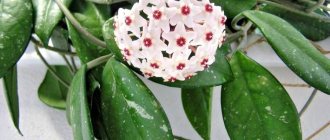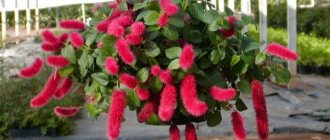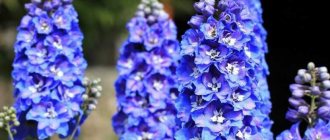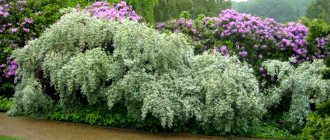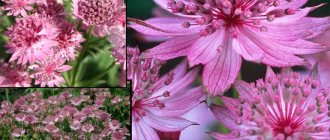One of the first plants in the garden to herald the arrival of spring is Erica from the Ericaceae family, offering gardeners an amazing range of foliage and flower palette. Most species are characterized by an exceptionally long period of abundant flowering from late February to April and from June to October.
The numerous genus Erica includes about 800 species of evergreen shrubs from 20 to 150 cm in height, differing in the color of foliage, flowers, appearance, shape and growing conditions. Many varietal forms have golden colored shoots, for example the “Golden Drop” variety.
Description
Erica is one of the representatives of the heather family, suitable for both landscape gardening and indoor floriculture. The plant is distinguished by a rich range of shades: you can plant Erica of different colors - and then the flowerbed or window sill in the house will become especially spectacular and picturesque.
As a rule, Erica is grown as an annual and dug up after flowering. However, the flowering is so long and decorative that it completely compensates for the short life of the plant.
Erica in the garden
The colorful palette and appearance of the perennial make it a sought-after plant in garden design. Shrubs planted in large groups produce a microclimate that promotes their development. The perennial looks great in combination with heather, low-growing conifers, cereals, Japanese spirea, barberry and decorative ground covers. The culture is perfect for creating rock gardens and alpine slides.
Compositions of different varietal forms with heather will allow you to obtain a stable play of shape and color throughout the season. The showy, intense ruby 'Kramers Rot' is planted in irregular groups or on scree, where it forms a strong color accent.
Kinds
Erica has many types - below is a detailed description of the most popular ones.
Herbal (ruddy)
A shrub reaching a height of no more than half a meter. If you plant several of these specimens side by side, the flowerbed will look like a solid, monochromatic carpet. Herbal Erica has about two hundred varieties, many of which are suitable for the climate of central Russia. Rarely cultivated at home, it is mostly used for landscape gardening. The color of this Erica is pink or crimson - very decorative.
Four-dimensional
A compact ornamental plant of gray-green, less often red, white or pink color. It is interesting because the leaves are collected in decorative whorls, making it especially impressive. Look at the photo of this wonderful plant.
Darlenskaya
A hybrid species that boasts particularly long flowering and a beautiful, elegant appearance. It is better to grow at home, since this Erica is not very resistant to frost. However, it is worth considering that the plant can reach a height of up to a meter, so not every corner of the apartment is suitable for it. The flowers have a pink, crimson or white tint.
Spiked
The small shrub can reach only 25 cm in height. Blooms in summer with soft pink inflorescences.
Gray (ash)
It reaches a height of 20-25 cm, has a decorative spreading crown. The flowers are ash-pink, the foliage is bluish. It grows better at home and does not tolerate cold winters.
general information
Erica is a member of the Heather family. About 700 species of the genus Erica are native to southern Africa. The rest can be found in the wild in Turkey, Mediterranean countries, as well as in the Caucasus and the island of Madagascar.
The British were the first to grow such a plant in the middle of the 18th century. One century later, breeders from Holland and Belgium began breeding Erica, as well as working on developing new varietal forms and hybrids. The flower was brought to the CIS countries in 1994 from Germany.
Today, numerous varieties of this plant are grown both in open ground and indoors. Pots with decorative bushes decorate rooms, window sills, balconies and loggias.
Description of the plant
Erica, in its appearance and structure, is very reminiscent of heather. Beginning gardeners often confuse these plants or believe that these are different names for the same flower. However, if you look closely at the bushes, you will notice some differences. For example, Erica's leaves are needle-shaped and located on the shoots at right angles, while heather's have scaly leaves and are lowered to the stems.
Erica has the appearance of evergreen shrubs with narrow leaves up to 1 centimeter in length, similar to pine needles. During the flowering period, plants are covered with a large number of small bell-shaped flowers; after withering, they retain their color and do not lose their decorative appearance for a long time. The inflorescences can be painted in various colors from white and milky to dark red and purple. In some varieties they gather at the tops of the shoots and form tassels, while in others they hide in the axils of the leaves along the entire length of the stems.
Erica seeds are very small in size. They have the ability, while in the soil, to remain viable for 10-20 years.
Where to plant
Let's find out which places are best suited for growing the beautiful Erica.
If the plant is intended for home cultivation, it will feel best on a lit windowsill. However, it is necessary to protect the plant from drafts so that Erica develops safely and blooms for a long time.
You should also protect the plant from direct sun - shade the window at midday or place the pot directly in a place with diffused (but plentiful) light. The fact is that exposure to direct sunlight causes the petals to turn pale, thus losing the decorativeness and effectiveness of the plant. Also, the sun can lead to a decrease in the quality of flowering - a decrease in the number of inflorescences.
If Erica is intended to be grown in the garden, it is advisable to place it under the protection of a hedge. In this way, the plant will be provided with both shelter from direct sun and a sufficient amount of rarefied light. Erica is not planted in lowlands and hollows - it does not tolerate stagnant moisture. In waterlogged soil, the plant will be susceptible to fungal diseases.
Features of cultivation
Let's find out the most important points regarding growing Erica at home.
Planting should be done in soil that has good drainage properties. As mentioned above, plants of this type cannot tolerate stagnant moisture. The soil needs to be loose, sandy; after watering, the soil should be loosened to provide air access to the roots of the plant.
The best soil in this case is considered to be the following mixture:
- peat - 3 parts;
- river sand - 1 part;
- turf soil - 1 part.
The plant blooms longest when kept in relatively cool conditions. If the air temperature is above +15 degrees Celsius, Erica will refuse to bloom for a long time, shortening the decorative period by several weeks.
Constant access to fresh air is very important for Erica - when growing this species at home, it is especially important not to forget about regular ventilation of the room.
Watering
Although the Erica plant is a drought-resistant crop, caring for it necessarily includes regular watering. It is necessary to ensure that the soil is always moist. The water must be soft and at a certain temperature. When the soil dries out, especially abundant watering is required. The potted plant can be completely immersed in water for half an hour. The Erica plant is very sensitive to air humidity. Therefore, it is recommended to spray the ground part periodically.
Landing
Let's get acquainted with the features of planting Erica.
Young Erica seedlings are placed in the ground for permanent residence in early spring, before the start of active vegetation processes. If the transplant comes from a container, it can be done in the summer. Before planting, it is important to make sure that there are drainage holes at the bottom of the pot - this is important to ensure moisture circulation. Drainage is laid at the bottom, and only after that soil is poured.
If the plant is intended to be grown in the garden, you must dig a hole in advance. A depth of 20-25 cm will be enough - the roots of the plant are not too long. At the bottom of the dug hole, it is also necessary to lay a drainage layer of small bricks or crushed stone, and then pour the prepared soil on top.
The seedling (either in a pot or in a garden) is buried in the soil up to the root collar so that the latter is above ground level. If several specimens are planted at the same time, a distance of half a meter must be maintained between them.
Reproduction
Erica is usually propagated vegetatively. Young shoots are obtained from cuttings and by layering. Below are both methods in more detail.
Layerings
To get a viable, strong cutting of a plant, you need to take the strongest shoot from the apical one, separate it from the mother bush, dig it shallow into the ground and water it sufficiently. Secure the shoot with a hairpin so that it does not fall prematurely without having time to take root. The procedure is carried out in the spring: it is not advisable to carry it out in the summer and autumn, since the plant has less chance of successful rooting.
Cuttings
To obtain a cutting, it is necessary to cut off a small apical shoot (the strongest and strongest). The length of the shoot should be from seven to ten centimeters. Before rooting, the cuttings are treated with a root stimulator. Then drop it into a loose peat-sand mixture (2 parts peat, one sand).
During the rooting period, cuttings should not be exposed to light and heat, but in a cool place. The optimal temperature is +5-15 degrees. In addition, it is important to maintain optimal soil moisture. To make the cutting take root faster, you can cover the top of the pot with a plastic cap.
In addition to the methods listed above, Erica can be propagated by simply dividing one mother bush into several when transplanting. For professionals, the method is more complicated: with seeds. In this case, the seeds are planted in peat in the spring without being buried and germinated in a warm place under glass or film. But as soon as the first shoots appear, the container must be immediately placed in a cool place, and the young plants can then be grown there.
Choice of terms
It is best to plant Erica in the spring, when the soil temperature reaches approximately +10 degrees. The cooler the climate, the later it is recommended to carry out the procedure.
In autumn, it is recommended to plant seedlings only in the southern regions so that the young plants have time to take root normally. Otherwise they will simply freeze.
Erica will decorate any garden with her decorative look. Photo source: https://glav-dacha.ru
Care
Let's learn how to properly care for a plant.
Watering, loosening
It is better to water Erica with soft, settled water that does not contain mineral impurities. In hot weather, the shrub needs more abundant watering, however, waterlogging and stagnation of moisture in the soil should not be allowed. It is advisable to carry out loosening immediately after watering. The procedure must be carried out shallowly, since the roots of Erica lie close to the surface.
Trimming
For the first 2-3 years after planting, Erica does not need pruning. After the third year, formative pruning is required every year (however, shallow). The procedure can be carried out either in the spring before the active growing season begins, or in the fall, when Erica has already faded. When pruning, cut off the upper part of the shoot to the inflorescences.
Top dressing
The plant is fed once a year - in the spring. It is advisable to use mineral fertilizers for feeding, since Erica does not tolerate organic matter well. Complex formulations like Kemira are optimal, but you can also use ready-made formulations for rhododendrons and azaleas.
Important: when you water the plant with a nutrient composition, make sure that the liquid gets only under the root and not on the leaves. Otherwise, a burn may occur.
Diseases and pests
Erica's roots are very thin, so they are easily susceptible to putrefactive processes. If the plant begins to shed its leaves, this may indicate a lack of light or rotting of the rhizomes. Erica can often be susceptible to powdery mildew. The disease must be controlled with fungicides.
Erica is often attacked by mites and aphids. To get rid of pests, you need to spray the leaves and stems with alcohol from a spray bottle. This should be done no more than once every 3-5 days, after removing the plant from the sunny side so that the remaining alcohol does not cause the leaves to burn. Commercial insecticides are also suitable for effective pest control.
Wintering
If the plant is in a pot at home, it can overwinter on the same windowsill. Just water Erica less and do not carry out any care procedures before the growing season begins.
If the plant is in the garden, then some of its varieties will require additional winter shelter. If the climate is very harsh, then it is better to cover all specimens of Erica, regardless of the variety: this way there will be a greater chance that in the spring the plant will come to life and begin to grow.
In order to cover, the root circle is mulched with a layer (10 cm) of dry foliage or peat. The part of the plant that remains above the ground is covered with spruce branches. In the spring, as soon as the sun begins to warm up steadily, the cover with spruce branches is removed and the mulch layer is raked away.
Trimming Erica
The bushiness of the plant is stimulated by annual pruning immediately after flowering. The shoots are cut at the height of faded flowers and only the part where the leaves are present, since woody stems do not produce new shoots. The procedure ensures the maintenance of a beautiful, compact shape of the plantings and promotes abundant flowering the following year. Give preference to asymmetrical pruning, which allows you not to lose the natural appearance of the plant.
When planting or transplanting Erica, be careful not to disturb the earthen ball, as the plant has a fibrous root system and does not like to have its roots disturbed.
Propagation is carried out by cuttings or air layering. The second method is simpler and faster.

